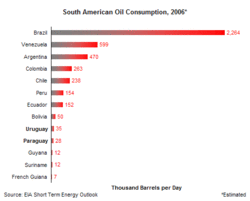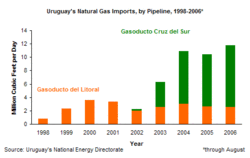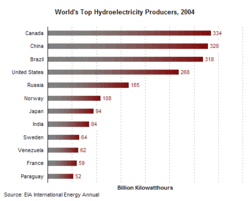Energy profile of Paraguay and Uruguay
Contents
Introduction Maps of Paraguay and Uruguay. (Source: EIA (Energy profile of Paraguay and Uruguay) )
Paraguay is a small, South American country and member of MERCOSUR. Its economy depends largely upon agriculture, which represents one-quarter of the country’s economic activity and almost all of its exports. Following stagnant economic growth since the late 1990s, Paraguay has seen its economy rebound in recent years. The country’s real gross domestic product (GDP) grew by 3.3 percent in 2005, following growth of 2.9 percent in 2004. A combination of economic growth in neighboring Brazil and Argentina and high world prices for its agricultural exports have fueled Paraguay’s economic recovery.
Uruguay suffered through an economic crisis during 1999-2002, with average real gross domestic product (GDP) contraction of minus 4.7 percent per year during that period. Uruguay is a member of MERCOSUR, and its economy is highly integrated with those of its MERCOSUR partners; as a result, economic and financial instability in Brazil and Argentina, the two largest economies in MERCOSUR, was a prime cause of Uruguay’s economic troubles. In recent years, though, the economy has rebounded, with real GDP growth of 12.3 percent in 2004 and 5.2 percent in 2005. A reduction in inflation, increasing world prices for Uruguay’s agricultural exports, revived economic growth in other MERCOSUR economies, and a $2.9 billion aid package from the International Monetary Fund (IMF) have all driven Uruguay’s economic recovery.
Oil
 South American Oil Consumption, 2006. (Source: EIA)
South American Oil Consumption, 2006. (Source: EIA) EIA estimates that Paraguay consumed 28,000 bbl/d in 2006, while Uruguay consumed 35,000 bbl/d. Neither country currently produces any crude oil. In February 2006, Paraguay’s Public Works Ministry announced that oil had been discovered in the western Chaco region by British oil company CDS, though CDS stated that the reservoir was too tight to facilitate unassisted oil production.
Downstream
State-owned Petroleos Paraguayos (Petropar) has a monopoly on all crude oil and petroleum product sales and imports in Paraguay. It operates Paraguay's sole refinery, the 7,500-bbl/d Villa Elisa facility. Uruguay also has a single oil refinery, the 50,000-bbl/d La Teja facility, operated by state-owned Administracion Nacional de Combustibles Alcohol y Portland (ANCAP).
Like many oil-importing countries in the Western Hemisphere, Paraguay and Uruguay have tried to foster the development of special deals for importing crude oil and refined products from Venezuela. Both countries signed deals in 2005 to receive crude oil imports from Venezuela under preferential financing terms. In December 2005, ANCAP and PdVSA, the Venezuelan national oil company, agreed to fund a study for the proposed doubling of the capacity at the La Teja plant. The project, which would cost an estimated $800 million, would also upgrade facilities at the refinery so that it could handle heavier Venezuelan crude varieties.
Natural Gas
Paraguay has no proven natural gas reserves, and it neither produces nor consumes natural gas. In recent years, the country has sought to promote the consumption of natural gas as a way to decrease the use of firewood and charcoal, which has contributed to deforestation in the country. However, barriers to natural gas consumption include a lack of domestic natural gas production and the absence of import pipelines.
Uruguay has no proven natural gas reserves. In an attempt to diversify its energy usage away from oil and hydroelectricity, Uruguay began importing natural gas from Argentina in 1998. Since then, the country’s natural gas consumption has steadily increased, reaching 4.2 billion cubic feet (Bcf) in 2004. The industrial sector consumes the largest share of this total.
Exploration Efforts
Paraguay has attracted some interest from international natural gas companies, with UK-based CDS Oil & Gas announcing in early 2004 that it had successfully completed a production test at its Independencia-1 well in the northwestern part of the country. Other companies that have signed exploration concessions with Paraguay’s government include H.A & E.R. Exploraciones, Pilcomayo Petróleos S.A., Hidroener Consultora, Guaraní Exploration, Union Oil, Paraguay Gas, Boreal Petróleos, Aurora Petróleos and Amerisur. In June 2006, ANACP announced that it had completed an appraisal of potential natural gas reserves in Uruguay’s offshore Punta del Este basin. According to the company, the basin contains at least 1-2 trillion cubic feet (Tcf) of potential reserves, though there has not been any actual exploration of the area. ANACP hoped to bring first production from the area onstream by 2015.
Sector Organization
Gaseba and Conecta are responsible for distributing natural gas in Uruguay. Gaseba distributed natural gas in Montevideo, whereas Conecta controls distribution in the rest of the country. Gaz de France owns a majority stake in Gaseba. Brazil’s Petrobras has controlled Conecta, since it purchased a majority stake in the company from Spain’s Union Fenosa in 2005.
Imports
Paraguay has pursued several natural gas import options. In 2001, Brazil proposed the Gas Integration Project (Gasin), a natural gas pipeline linking Bolivia, Argentina, Paraguay, and Brazil. There has not been much progress to date on the implementation of this proposal. In 2002, the Bolivian and Paraguayan governments signed a preliminary agreement allowing for the construction of a pipeline from southern Bolivia to Asuncion. In June 2006, the two governments approved a plan to move forward with the pipeline, which would have an initial capacity of 700 million cubic feet per day (Mmcf/d) and require an investment of at least $2 billion.
 Uruguay's Natural Gas Imports, by Pipeline, 1998-2006. (Source: EIA)
Uruguay's Natural Gas Imports, by Pipeline, 1998-2006. (Source: EIA) There are two natural gas pipelines connecting Uruguay to Argentina. The first, the CR. Federico Slinger (also know as Gasoducto del Litoral), runs 12 miles from Colon, Argentina to Paysandu, in western Uruguay. The pipeline, constructed and operated by ANCAP, began operations in November 1998 and has an operating capacity of 4.9 Mmcf/d. The second is the Gasoducto Cruz del Sur (GCDS), also known as the Southern Cross Pipeline. Operated by a consortium led by British Gas, the GCDS extends 130 miles from Argentina’s natural gas grid to Montevideo and has a capacity of 180 Mmcf/d. The GCDS project also holds a concession for a possible, 540-mile extension of the pipeline to Porto Alegre, Brazil.
Issues Concerning Imports
Due to natural gas shortages, Argentina has recently begun interrupting its natural gas exports to Uruguay and Chile. This has raised concerns in Uruguay about the future security of its natural gas supply and jeopardized plans to increase domestic natural gas consumption. As a result, Uruguay has discussed the possibility of importing natural gas directly from Bolivia; in March 2006, Uruguay and Bolivia agreed to launch a study to consider the feasibility of such a plan.
Electricity
Paraguay generated 51.8 billion kilowatthours (Bkwh) of electricity in 2004, while consuming only 3.1 Bkwh. Almost all of the country’s electricity consumption comes from a single facility, the bi-national Itaipu hydroelectric dam (see below). Paraguay is one of the world’s largest net exporters of electric power. In 2004, Uruguay generated 8.2 billion kilowatthours (Bkwh) of electricity and consumed 9.9 Bkwh. To make up for this shortfall, Uruguay imported electricity from Argentina and Brazil.
Sector Organization
Paraguay's state-owned utility, Administracion Nacional de Electricidad (ANDE), controls the country’s entire electricity market, including generation, distribution, and transmission. It operates a single hydroelectric dam, Acaray, and six thermal power plants, with total installed capacity of 220 megawatts (MW). The company is also responsible for Paraguay’s share of two bi-national hydroelectric facilities. ANDE operates 2,100 miles of transmission lines and 670 miles of distribution lines. Over 92 percent of the country has electricity service.
The Administracion Nacional de Usinas y Transmisiones Electricas (UTE) is responsible for transmission and distribution activities in Uruguay, as well as most power generation. The Unidad Reguladora de la Energía y Agua (URSEA) has principle regulatory oversight of the sector. In 1997, Uruguay changed its electricity laws to permit independent producers to generate power, introducing competition to the sector. However, UTE has the option of taking 40 percent stakes in any new power plants built by private developers.
Hydroelectricity
 World's Top Hydroelectricity Producers, 2004. (Source: EIA)
World's Top Hydroelectricity Producers, 2004. (Source: EIA) Paraguay operates two hydroelectric dams in cooperation with its neighbors: Itaipu (Brazil) and Yacyreta (Argentina). The Itaipu dam is the largest hydroelectric facility in the world, though, once completed, the Three Gorges Dam in China will be larger. Itaipu has 18 generators and a total installed capacity of 12,600 MW, evenly shared between Paraguay and Brazil. In 2004, Paraguay consumed 16 percent of its share of Itaipu production, exporting the rest to Brazil. Yacyreta, completed in 1999, has 20 generators and a total installed capacity of 3,500 MW. Paraguay consumes less than 1 percent of its share of Yacyreta’s production, exporting the rest to Argentina. In September 2006, Ente Binacional Yacyreta, the binational company responsible for operating the facility, announced that it was cancelling the planned Ana Cua expansion of the facility.
Four hydroelectric facilities provided the bulk of Uruguay’s electricity generation: Terra (152 MW), Baygorria (108 MW), Palmar (333 MW), and Salto Grande (945 MW). The remainder of the country’s electricity generation comes from thermal power plants and mobile diesel generators, which UTE only calls upon during peak demand, or when weather conditions suppress output from its hydroelectric facilities. In May 2006, Uruguay and Argentina launched a binational study on a proposed new hydroelectric facility near Salto Grande with an installed capacity of 265 MW.
Under normal weather conditions, Uruguay's hydroelectric plants cover the country’s electricity demand. However, seasonal variations can leave Uruguay at a severe power deficit, forcing the country to rely upon imports or costly oil- and diesel-fired generators. In 2001, UTE announced a tender for a new, 400-MW, natural gas-fired power plant that would help diversify the country’s electricity supply. However, a combination of factors forced Uruguay to withdraw the tender in early 2005, including the election of a new president in early 2005, questions regarding the future of natural gas imports from Argentina, the cost of the facility ($200 million), and the construction time (26 months) of the project. Instead, UTE offered a substitute tender for the construction of two small, 100-MW turbines capable of consuming either natural gas or fuel oil. UTE awarded this tender to General Electric (GE) in August 2005, with GE committing to build the first plant within 180 days of finalizing the contract.
International Trade
As mentioned above, Paraguay is a major exporter of electric power to neighboring Argentina and Brazil. Uruguay, on the other hand, must often import electric power due to season variations in its hydroelectric output; on average, electricity imports peak in March. Most of Uruguay’s imports come from Argentina, which reached 1.5 Bkwh during the first nine months of 2006. In recent years, Uruguay has begun to also import increasing amounts of electricity from Brazil. During the first nine months of 2006, it imported 0.8 Bkwh of electricity from Brazil. Uruguay has also proposed the construction of additional infrastructure to support greater Brazilian exports, including a new high-tension transimmion line between the two countries and new, coal-fired power plant in southern Brazil that would target the Uruguayan market.
Further Reading
- Energy Information Administration (EIA). Country Information on Paraguay
- Energy Information Administration (EIA). Country Information on Uruguay
- U.S. Department of State Background Notes: Paraguay
- U.S. Department of State Background Notes: Uruguay
- U.S. Department of State 1999 Country Report on Economic Policy and Trade Practices - Uruguay
| Disclaimer: This article is taken wholly from, or contains information that was originally published by, the Energy Information Administration. Topic editors and authors for the Encyclopedia of Earth may have edited its content or added new information. The use of information from the Energy Information Administration should not be construed as support for or endorsement by that organization for any new information added by EoE personnel, or for any editing of the original content. |